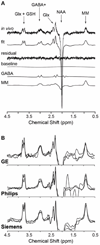Spectral editing in 1 H magnetic resonance spectroscopy: Experts' consensus recommendations
- PMID: 32946145
- PMCID: PMC8557623
- DOI: 10.1002/nbm.4411
Spectral editing in 1 H magnetic resonance spectroscopy: Experts' consensus recommendations
Abstract
Spectral editing in in vivo 1 H-MRS provides an effective means to measure low-concentration metabolite signals that cannot be reliably measured by conventional MRS techniques due to signal overlap, for example, γ-aminobutyric acid, glutathione and D-2-hydroxyglutarate. Spectral editing strategies utilize known J-coupling relationships within the metabolite of interest to discriminate their resonances from overlying signals. This consensus recommendation paper provides a brief overview of commonly used homonuclear editing techniques and considerations for data acquisition, processing and quantification. Also, we have listed the experts' recommendations for minimum requirements to achieve adequate spectral editing and reliable quantification. These include selecting the right editing sequence, dealing with frequency drift, handling unwanted coedited resonances, spectral fitting of edited spectra, setting up multicenter clinical trials and recommending sequence parameters to be reported in publications.
Keywords: J-difference editing; consensus recommendations; multiple quantum filtering; spectral editing; γ-aminobutyric acid, glutathione.
© 2020 John Wiley & Sons, Ltd.
Figures




References
-
- Mescher M, Merkle H, Kirsch J, Garwood M, Gruetter R. Simultaneous in vivo spectral editing and water suppression. NMR Biomed. October 1998;11(6):266–272. - PubMed
-
- Star-Lack J, Spielman D, Adalsteinsson E, Kurhanewicz J, Terris DJ, Vigneron DB. In vivo lactate editing with simultaneous detection of choline, creatine, NAA, and lipid singlets at 1.5 T using PRESS excitation with applications to the study of brain and head and neck tumors. J Magn Reson. August 1998;133(2):243–254. - PubMed
-
- Andreychenko A, Boer VO, Arteaga de Castro CS, Luijten PR, Klomp DW. Efficient spectral editing at 7 T: GABA detection with MEGA-sLASER. Magn Reson Med. October 2012;68(4):1018–1025. - PubMed
-
- Near J, Simpson R, Cowen P, Jezzard P. Efficient gamma-aminobutyric acid editing at 3T without macromolecule contamination: MEGA-SPECIAL. NMR Biomed. December 2011;24(10):1277–1285. - PubMed
Publication types
MeSH terms
Substances
Grants and funding
LinkOut - more resources
Full Text Sources

